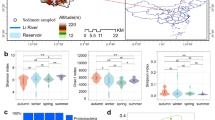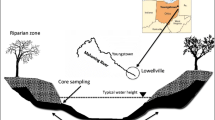Abstract
Objective
Microbial communities are a central component of trophic dynamics and biogeochemical processes on coastal systems, since most of the processes in sediments are mediated by microorganisms and carried out by enzymes. Microorganisms play a key role in decomposition processes in salt marsh sediments, although the significance of microbial dynamics is largely unexplored. A culture-dependent (Ecoplate) and a culture-independent (extracellular enzyme activity [EEA]) approaches were evaluated in their ability to distinguish the catabolic potential among sediments from Tagus estuary salt marshes with different proximities to anthropogenic sources.
Methods
Ecoplate was used to analyse the salt marsh community-level physiological profiles (CLPPs). Results were expressed as the net area under the curve for each of the 31 response wells over a 3-day incubation period in two sediment horizons. The catabolic profiles for salt marsh samples were analysed by Principal Component Analysis (PCA) and hierarchic clustering methods. EEA was analysed by fluorescein diacetate (FDA) hydrolysis in two sediment horizons. The FDA is catalysed by extracellular enzymes, i.e. esterases, lipases and partially by proteases. Results were expressed as μg g−1d wt h−1.
Results and Discussion
In this study the CLPP and EEA data were not generally correlated. In Corroios salt marsh only in surface sediments higher net areas corresponded to higher extracellular enzymatic activity, and in Alcochete deep sediments lower net areas corresponded to lower enzymatic activity. Although EEA profiles more directly reflect the inherent activity of resident community in each salt marsh sample, the CLPP profiles provide better assessments of diversity.
Similar content being viewed by others

References
Boetius A, Ferdelman T, Lochte K (2000): Bacterial activity in sediments of the deep Arabian Sea in relation to vertical flux. Deep-Sea Res Pt II 47, 2835–287
Brotas V, Plante-Cuny MR (1998): Spatial and temporal patterns of microphytobenthic taxa of estuarine tidal flats in the Tagus Estuary (Portugal) using pigment analysis by HPLC. Mar Ecol-Prog Ser 171, 43–57
Caçador I, Mascarenhas I, Mascarenhas P (1999): Biomass of Spartina maritima, Halimione portulacoides and Arthrocnemum fruticosum in Tagus Estuary Salt Marshes. Prog Biometeorol 13, 33–42
Caçador I, Vale C, Catarino F (1999a): Relationships between metal concentrations and organic matter content in the Tagus estuary salt marsh sediments. In: Lieth H (ed), Halophyte uses in different climates I. Backhuys Publishers, Leiden, The Netherlands, pp 105–112
Caçador I, Costa AL, Vale C (2004): Carbon storage in Tagus Salt Marsh Sediments. Water Air Soil Poll, Focus 4, 701–714
Caçador I, Costa AL, Vale C (in press): Degradation of belowground litter of salt marsh plants and retention of metals in sediments: A natural remediation process for aquatic system ‘Water Quality: From Assessments and Ecotoxicology to Remediation’
Caravaca F, Alguacil M, Torres P, Roldán A (2005): Microbial activities and arbuscular mycorrhizal fungi colonization in the rhizosphere of the salt marsh plant inula crithmoides l. along a spatial salinity gradient. Wetlands 25, 350–355
Cartaxana P, Caçador I, Vale C, Falcão M, Catarino F (1999): Seasonal Variation of Inorganic Nitrogen and Net Mineralization in a Salt Marsh Ecosystem. Mangroves Salt Marshes 3, 127–134
Choi KH, Dobbs FC (1999): Comparison of two kinds of Biolog microplates (GN and ECO) in their ability to distinguish among aquatic microbial communities. J Microbiol Meth 36, 203–213
Costa AL, Caçador I (2003): Chemical composition variation during root decomposition in Tagus estuary salt marshes. In: Lieth H (ed), Tasks for Vegetation Science-38. Cash Crop Halophytes: Recent Studies. Kluwer Academic Publishers, UK, pp 97–102
Dame R (1986): The outwelling hypothesis and North Inlet, South Carolina. Mar Ecol-Prog Ser 33, 217–229
Garland JL, Mills AL (1994): A community-level physiological approach for studying microbial communities. In: Ritz K, Dighton J, Giller KE (eds), Beyond the Biomass. Wiley-Sayee Publication, pp 77–83
Guckert JB, Carr GJ, Johnson TD, Hamm BG, Davidson DH, Kumagai Y (1996): Community analysis by Biolog: Curve integration for statistical analysis of activated sludge microbial habitats. J Microbiol Meth 27, 183–197
Hackett CA, Griffiths BS (1997): Statistical analysis of the time-course of Biolog substrate utilization. J Microbiol Meth 30, 63–69
Hines ME, Knollmeyer SL, Tugel JB (1989): Sulfate reduction and other sedimentary biogeochemistry in a northern New England salt marsh. Limnol Oceanogr 34, 578–590
Howard DM, Howard PJA (1993): Relationship between CO2 evolution, moisture content and temperature for a range of soils types. Soil Biol Biochem 25, 1537–1546
Insam H (1997): A new set of substrates proposed for community characterisation in environmental samples. In: Insam H, Rangger A (eds), Microbial Communities. Springer Verlag, pp 259–260
Kang H, Freeman C, Lee D, Mitsch WJ (1998): Enzyme activities in constructed wetlands: Implication for water quality amelioration. Hydrobiologia 368, 231–235
Köster M, Dahlke S, Meyer-Reil LA (1997): Microbiological studies along a gradient of eutrophication in a shallow coastal inlet in the southern Baltic Sea (Nordrügenshe Bodden). Mar Ecol-Progr Ser 152, 27–39
Lachmund C, Manz W (2005): Substrate utilization profiles of natural microbial communities for the characterization of river sediments with different contamination levels. Workshop ‘Functional and genetic characterization of microbial communities: Sole-carbon-source test’. Abstracts book, Lisbon University Faculty of Sciences, Lisbon
Mendelssohn IA, McKee KI, Patrick WH (1981): Oxygen deficiency in Spartina alterniflora roots: Metabolic adaptation to anoxia. Science 241, 439–441
Meyer-Reil LA (1986): Measurement of hydrolytic activity and incorporation of dissolved organic substrates by microorganisms in marine sediments. Mar Ecol-Prog Ser 31, 147–149
Meyer-Reil LA (1987): Seasonal and Spatial Distribution of Extracellular Enzymatic Activities and Microbial Incorporation of Dissolved Organic Substrates in Marine Sediments. Appl Environ Microb 53, 1748–1755
Meyer-Reil LA, Köster M (2000): Eutrophication of Marine Waters: Effects on Benthic Microbial Communities. Mar Pollut Bull 41, 255–263
Paixão SM, Santos P, Baeta-Hall L, Anselmo AM (2003a): Alternative Inocula as Activated Sludge Surrogate Culture for a Toxicity Test. Environ Toxicol 18, 37–44
Paixão SM, Santos P, Tenreiro R, Anselmo AM (2003b): Performance evaluation of a mixed and pure inocula as surrogate culture in BOD5 test. World J Microb Biot 19, 539–544
Poremba K (1995): Hydrolytic enzymatic activity in deep-sea sediments. FEMS Microbiol Ecol 16, 213–222
Prieto B, Silva B, Lantes O (2004): Biofilm quantification on stone surfaces: Comparison of various methods. Sci Total Environ 333, 1–7
Rieling T, Gerbersdorf S, Stodian I, Black HJ, Dahlke S, Köster M, Meyercordt J, Meyer-Reil LA (2000): Benthic microbial decomposition of organic matter and nutrient fluxes at the sedimentwater interface in a shallow coastal inlet of the southern Baltic Sea (Nordrügensche Bodden). Muddy Coast Dynamics and Resource Management, 175–184
Sinsabaugh RL, Foreman CM (2001): Activity Profiles of Bacterialplankton in a eutrophic river. Freshwater Biol 46, 1239–1249
Waisel Y (1972): Biology of halophytes. Academic Press, New York, USA
Wetzel RG (1992): Wetlands as metabolic gates. J Great Lakes Res 18, 529–532
Wobus A, Bleul C, Maassen S, Sheerer C, Schuppler M, Jacobs E, Röske I (2003): Microbial diversity and functional characterization of sediments from reservoirs of different trophic state. FEMS Microbiol Ecol 46, 331–347
Schnürer J, Rosswall T (1982): Fluorescein diacetate hydrolysis as a measure of total microbial activity in soil and litter. Appl Environ Microb 43, 1256–1261
Tayler S, May E (1995): A comparison of methods for the measurement of microbial activity on stone. Stud Conserv 40, 163–170
Taylor JP, Wilson B, Mills MS, Burns RG (2002): Comparison of microbial numbers and enzymatic activities in surface soils and subsoils using various techniques. Soil Biol Biochem 34, 387–401
Vale C, Caetano M, Raimundo J (2003): Incorporation of trace elements on Iron-rich concretions around plant roots of Tagus Estuary salt marshes (Portugal). J Soils Sediments 3, 208–212
Victorio L, Gilbride KA, Allen DG, Liss SN (1996): Phenotypic fingerprinting of microbial communities in wastewater treatment systems. Water Res 30, 1077–1086
Zak JC, Willig MR, Moorheadand DL, Wildman HG (1994): Functional diversity of microbial communities: A quantitative approach. Soil Biol Biochem 26, 1101–1108
Author information
Authors and Affiliations
Corresponding author
Additional information
ESS-Submission Editor: Prof. Dr. Peter Schroeder, Institute of Soil Ecology, Department of Rhizosphere Biology, GSF — National Research Center for Environment & Health, Ingolstaedter Landstrasse 1, 85758 Neuherberg, Germany (peter.schroeder@gsf.de)
Rights and permissions
About this article
Cite this article
Costa, A.L., Paixão, S.M., Caçador, I. et al. CLPP and EEA profiles of microbial communities in salt marsh sediments. J Soils Sediments 7, 418–425 (2007). https://doi.org/10.1065/jss2007.02.211
Received:
Accepted:
Published:
Issue Date:
DOI: https://doi.org/10.1065/jss2007.02.211



